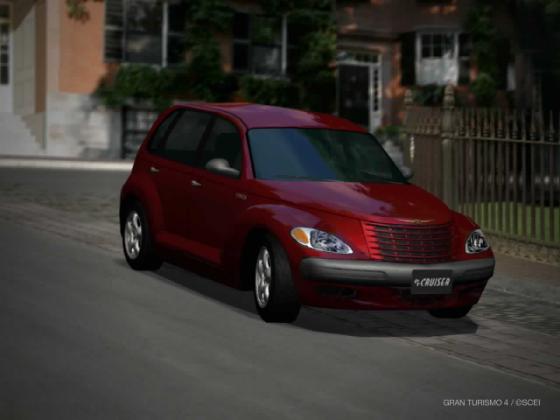|
STATS
Year: 2000-2003 ``````````````````````````````` Country:
USA
Type: 5-Door Hatchback ``````````````` Host: GT3, 4 & 5
Price: $17,980 (GT3), $16,390 (GT4), $12,550
(GT5)
Length: 168.9" // Width: 67.0" // Height: 62.9"
Wheelbase: 103.0"
Overhang; @5' 6"
Track: 58" [F]
58.2" [R]
Ground Clear: 6.5"
Weight: 2,799 lbs.
Wgt. Dist: 59/41%
Body Construction: unit steel
Layout:
Front Engine / Front Drive
Tires: 195/65R-15
F. Suspension: Macpherson strut / coils / anti-roll bar
R. Susp: solid
twist beam axle / tr. arms / coils / anti-roll bar
Brakes: vented discs / drums
*GT3 may
have had full engine break-in. not sure if oil was changed
*GT4 Cruiser had oil change performed.
*GT5 Cruiser
had oil and no other maintenance
Engine: 2.4 liter DOHC inline 4
Construction: aluminum block & head
````````````````````````````GT3``````````````````````````````````GT5````
Tested hp: ````157 @ 5,000 rpm
148 @ 5,200
Tstd. Torque: 172 @ 4,000 rpm
165 @ 4,000
Credits per hp: $114.52
`$84.79
Pounds per HP: 17.83
18.91
Hp per liter: 64.6
60.9
Aspiration: normal
Fuel Syst: seq. multipoint fuel injection
Valves / Cyl: 4
Bore x Stroke; 3.44
x 3.99"
Compression: 9.4:1
GT4 Redline: 6,000 // Rev Limit: 6,500
GT5 Idle: 750 // Redline: 6,000 // RPM
Limit: 6,500
Transmission: 5-speed manual
Differential: open type
0-60 mph:
GT3: 9.630 seconds
GT4: 9.716 seconds
GT5: 9.396 seconds
0-100mph:
GT3: 25.066 seconds
GT4: 24.583 seconds
GT5: 26.609 seconds
400 M:
GT3:
17.375 @ 82 mph GT4: 17.429 @ 84 mph GT5: 17.349 @ 84 mph
1000
M: GT3: 30.861 @ 107.1 mph GT4: 31.052
@ 107 mph GT5: 31.279 @ 105 mph
GT3Test Track: 3:12.274
GT4 Test Curse: Not Tested
GT5 Daytona Lap: 1:15.980
100-0 mph:
GT3:
3.533 seconds
GT4: 4.08 seconds
GT5: 5.500 seconds
Top Gear RPM @ 60 mph: 2850 rpm
Top Speed at Redline:
1st: 32.6 mph
2nd: 52.1 mph'
3rd: 76.1 mph
4th: 105.8
mph
5th: 127.8 mph @ 6,000 rpms (GT3)
123.47 mph @ 5,750 rpms (GT4)
119.3 mph @ 5,700 rpms (GT5)
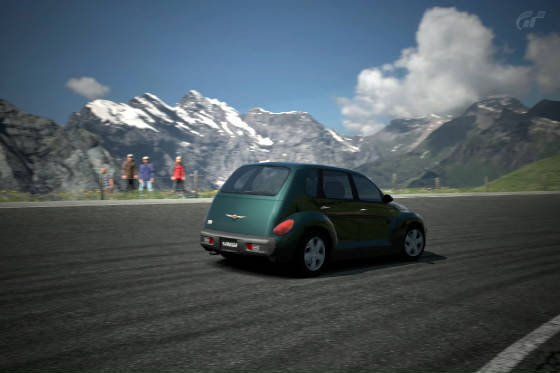
--------------------EXTERIOR--------------------
Is it a car? A wagon? A rural mail-delivery truck? Call-A-Geek
vehicle?
My first GT3 surprise was this "thing"... the ungainly Chrysler PT Cruiser. My second? Polyphony eschewed
the Dodge Neon, which I totally expected would have made it from GT2, and is a better racer than the top-heavy PT. It
seems perhaps Chrysler felt they needed to promote the PT when GT3 was in development, which in the year 2001 was a still
a fairly new model, and this is why it's in the game yet the Neon got nixed.
Even tho the PT Cruiser seems more suited
to be the family gofer than it does a hot-hatch, it does have a few merits. It is inexpensive. There are no other American
cars that can be bought from the $18,000 GT3 starts us with; matter of fact, you can't start GT1 or 2 with an American at
all. In GT4, it is not possible to buy a PT from Day 1 unless you've transferred the $100,000 in credits from GT3. The PT
also appears in GT5, but since it's now a used car it may be hard to find. It's still cheap though; matter of fact it's at
its cheapest in this game.
The PT is also surprsingly capable at beginning of any of these games, since
it'll smoke the Sunday Cup completely stock, and then move up thru the ranks with just a little help from Mopar. I'm
not sure if it would make a good car for a novice player...but we'll get to that later.
In real-life, there is also
a GT version of the PT Cruiser, which is a 2-door. Oddly, we don't get a 2-door in either game, even tho it's
probably more capable as a race car. Instead, we get the lunkish 5-door model.
Also, it seems Polyphony Digital has
kept their charming habit of misquoting data, since real-life PT Cruisers weigh around 3,125 pounds. Or maybe
Chrysler provided false info? Either way, just imagine if the game-car slugged this much, it certainly wouldn't get very far!
Thanks to this mistake, the PT starts in our games 326 pounds lighter than it should.
Weight reductions remove a lot too; Stage One shaves just over 200 pounds, and Stage 2 brings it down to
a manageable 2,490. In either GT3 or GT4, final stage 3 weight is 2,378 pounds. During
the Beginner's League, most folks won't need anything more than Stage 1, which is easily affordable.
There's plenty
of internet info on the PT, about how it became one of Chrysler's strongest sellers and stuff, but I'm gonna skip it because
it's not all that interesting to gamers. Basically, I'm skipping it because I believe YOU would skip it. :)
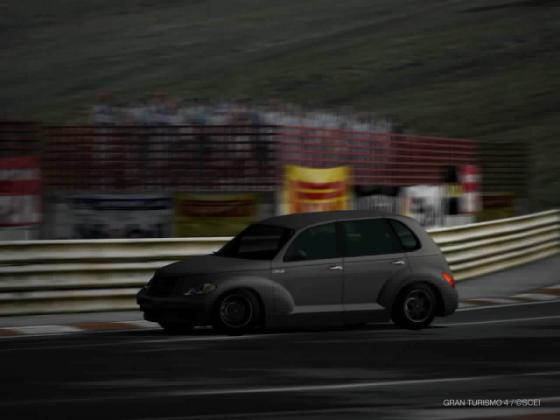
|
| Getting a lead at Yosemite |
----------------ENGINE / DRIVETRAIN----------------
I'm sure nobody will be surprised when I bring up the subject
of the PT's power--or lack of it. What we've got here is just a 4 cylinder, but it's a rather large 4 with
a mighty four-inch stroke...that's where all that torque comes from. This is a rather torquey engine...perhaps something
Chrysler customers crave is to have a bit of stomp when they're off to Red Lobster or Fuddrucker's, hauling other humans.
But one thing the PT Cruiser won't haul much of is ass! It's not a race car, after all.
The 6,000 rpm redline is a subtle giveaway here...we're not dealing with a high-revving Civic or Neon engine, folks. Most
of the power is created in the lower-5,000s, not exactly a 4-cylinder's prime. Still, it's notable (in GT3) that a totally
stock PT can be punched in 2nd gear off any starting line, and it will not over-rev or bog down...so long as you keep
the revs above 5,000 at the start. And that's with the TCS off, too. That's what is called "torque", my friends. In GT4, this
isn't possible with any of the "normal" (N) tires..but you can do it with sports.
MOPAR offers us a rather untypical lineup of parts (for an American) and GT3 or 4. We've got three
NA tunes and the usual balancing, port / polish, computer, and exhaust / filter parts, but what's unexpected are the two turbos
(and GT5 adds a third)! All this livens up the sluggish PT when we take it to the races, so by the time you're doing
the FF Challenges (GT3 or 4), you'll probably need to start tweaking the motor a bit with your first natural-aspirated tune,
perhaps. GT5's Muscle Car Championship in the Professional Series will require at a good stacking of power, but
before this the PT won't see much action during A-spec, not without over-killing the game to death. The PT is a very good
car for B-spec, though.
Monetarily, the big fat lemon here is the Stage 3 NA kit in GT3 or 4, which costs $70,000 yet
only provides 332 hp at the most (GT3). Only those of us with major pocket change will ever buy it. And then,
will we ever NEED it? So far, only the most extreme races require Stage 3 NA: the Pro-level FF Challenge in GT3 comes to mind;
and most folks probably tackle this in a Civic or Integra, no doubt.
The majority of Gran Turismo 3 racers will of course select the turbo anyways, which costs $58,000
less. Or they'll simply upgrade to a lighter, faster car. At the most, a PT with a Stage 2 turbo and all the right stuff will
burn 317 hp @ 5,100 rpm with 328.3 ft-lbs. @ 4,600 rpm and the NA parts yield
332 @ 5,600 rpms. GT4 provides slightly less: 299 bhp @ 5,200 with 309
foot-pounds @ 4,000 from the Stage 2 turbo, or 313 and 323 from the Stage
3 NA kit. Hey that's good.
...Unfortunately, it's not enough. The best thing about the PT Cruiser is it will rule most of
the Beginner's League in GT3 or 4, as well as some Pro-level and American events in GT4. It does have its place, since it
can enter the Sunday Cup, Clubman, FF series, NA & Turbo Tune series, Stars & Stripes, and others I'm possibly forgetting.
You WON'T need to fully tweak your engine to win any of these in GT3...matter of fact, light to medium-duty tuning will do.
The Turbo Cup at Route 11, and Stars & Stripes at Seattle II will be the most challenging events of the Cruiser's career
early on.
But this is it. No matter what, the PT simply hasn't got enough power to move on to the Amateur League.
Oh, it'll win an Amateur spot race here and there, it'll still baste the Amateur FF Challenge with surprisingly minimal tuning,
but it won't rule the Amateurs with an aluminum fist the way it rules the Beginner's League. In the Pros, the PT can tackle
the FF Challenge, but full weight-reductions are recommended. It may be able to finish the Seattle Enduro, too.
GT4's PT Cruiser will need more guts if you are to take it to some Pro-level races,
and then you'll need to make sure the Ai is carefully chosen so there isn't anyone too difficult to race against.
Only those who are counting their pennies will ever do this, however; there are simply too many other (better) cars waiting
for them.
Like I said, most exotic MOPAR parts are unnecessary. Rarely will experienced GTers need fully-modifyable
gears, full-limited slip, or install a triple-plate clutch, unless they're super-dedicated to this goofy automobile. The PT
is heavily prone to losing power in corners as it leans, so for the most part, a 1-way diff and sports suspension will help
massively, unless you dig all that tire smoke. A single-plate clutch will put down the power. Get what I'm saying? We
don't need to spend a whole lot on this one early on!
It's a great car to start the game off, but ultimately
it gets left in the garage, collecting dust and inspiring web-users to write all about their first GT3 auto at their favorite
online bulletin board.
GT5 is
the exception to all of this. Like I was saying earlier, it doesn't see much use in earlier A-spec races, then suddenly in
the Muscle Car Championship it can be quite a sleeper, slaying some V8-powered monsters. At best, the 2.4 liter 4 can produce
261 @ 5,900 and 246 foot-pounds at 4,900 with a Stage 3 NA kit, and if that's not enough,
the final Stage 3 turbo can stack up to 334 horses @ 5,900, matched with 300 foot-pounds
at 5,400! As we shall see, it's not really power that makes this
engine special, it's torque. Torque comes into play most of all as we're trying to move this one out of slower areas,
and it's often those middle-ish rpms that we'll feel this.
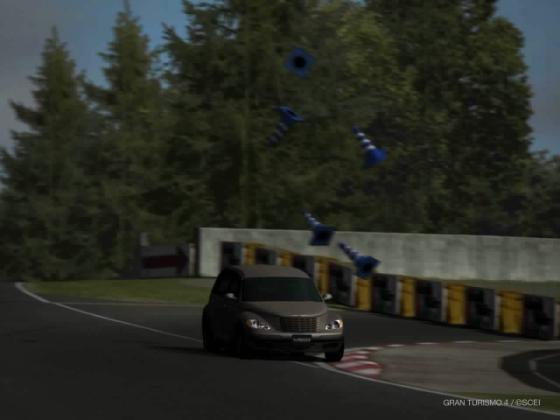
------------------CHASSIS / HANDLING---------------------
The results aren't in yet, but I'm casting my vote. This
may be THE clumsiest front-drive car you'll ever drive in a videogame! Oh, there are some klutzes out there: the
Mazda Demios, the Honda Lifes, the Taurus SHOs...but none of these even comes close to the PT Cruiser!
I mean here's the deal. Surely many of the cars mentioned above start on our Worst Handling list,
but you can at least TUNE them to react better once you've got some money! The PT? Even with soft tires and a semi-racing
suspension, it scales off the chart, and will proudly disappoint you again and again once you're really trying to attack some
of GT3's more challenging races, which is why I recommend just sticking to the front-drive races at a more advanced level.
The main thing to watch for; really, the only major fault the PT has, is understeer. But....we're
talking LOTS and LOTS of understeer! Hoards of it! You can tune and tune till your fingers are raw...it won't make a difference.
Part of this is the physics engine, which puts more realism into our games, but most of it must be derived from
the way the PT handles in real-life, which is what the physics engine is supposed to be replicating, anyways.
Early on when the races are slow, you can get away with driving your PT, letting it do its thing,
and it won't matter. Later on in some of the tougher A-license races where you'll need to take up entire corner paths
just to avoid a wall, the PT can no longer hide its worst behavior. So there's not much to add here.
Oh, and
using the E-brake shouldn't be a habit till you've got over 200 hp, or your lead in a race is comfortable. Weaker cars suffer
from lost speed even if you blip your e-brake a split second, and any time you'll save in corners gets added back on (and
then some) as the clumsy Cruiser gets back on its feet and the engine struggles.
Sports suspension & tires, maybe some medium slicks in the Route 11 Turbo Cup ....that's all you'll
need, really, if you're good in GT3. At the Pro level, you can buy more exotic parts. But like I said, the PT won't
get far in most of these races. In GT4, I found myself using "road" tires (N3) for the Sunday Cup, but upgraded to medium
sport tires (S2) for everything else.
In GT5, the PT is slightly improved. Yes it still understeers, and still has
a habit of breaking away its inside wheel if at least Stage 1 power is being used (and no limited-slip), but in this game
the PT offers somewhat better damage control.
In my first PT Cruiser race at Eiger Norwand, I even experimented
a bit and let the "Curser" get a little too deep into the first hairpin. Yes, the car understeered heavily, but I could at
least manage to get it turned thru the hairpin without any sort of massive calamities. GT5, with its Seasonal events, happens
to be the best game for a prospective driver to make some serious bucks with little effort (in comparison to GT3 and 4).
But during A-spec mode it's not often we'll actually need a PT Cruiser until (oddly) we are in the Professional Series.
Summary
Perhaps if this car had a longer career, it would be worth it for most folks, but by the time the
PT has left Seattle's Stars & Stripes (GT3) or the Clubman Cup (GT4), pack up the truck 'cause it's mostly all over.
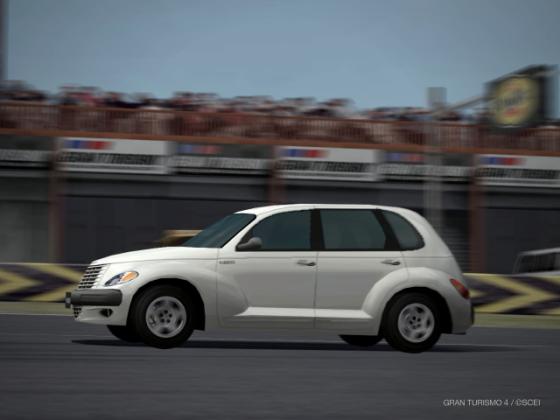
PROS---------------------------------------------
1). Lowly priced in any of the three Gran Turismos. We can begin to crush GT3 immediately, since this car
costs less than the 18,000 credits GT3 starts us with.
2). Good vehicle to start the game in GT3 or 4 since it'll easily out-pace many others during easy races while it's stock, or perhaps with
a few engine mods. The PT starts later in GT5, but still has its uses here and there.
3). A bit of a novelty
with its retro appearance.
4). Torquey engine. In the 3rd game, 2nd-gear launches always a possibility, even while
the car is stock. (Not true in GT4, though).
5). Great stability while braking
(truest in GT5).
CONS----------------------------------------------
1). That ‘retro’ thing I mentioned in Pro #3. Quite a few find the PT Cruiser (along with a slew
of other Chrysler products) ugly...could care less if they're innovative or nostalgic. Also, the PT Cruiser was new when GT3
was released (2001), but were a bit dated by the time GT4 hit the shelves in 2004, and bordering on ancient
in 2010 (GT5).
2). Poor acceleration, lowish overall speed.
3). Even when lightly-tweaked, the PT's torque
tends to spin wheels...a lot of the front-drive traction gets wasted unless the driver is wussing out with a TCS
system. Though this looks really cool at times, exit speed is getting lost in droves as we're having some Fast &
Furious Fun.
4). Short-career syndrome. The PT enters the games with a BANG, but it's all over soon for most
folks, especially if they're not so experienced.
5). Many of the parts one can buy wind up being a waste of credits...
become useless in the long run. How many of us really needed that racing suspension, carbon brake pads, or Stage 3 NA tune?
Ignore this one if you're experienced and can take on more challenging races, or are playing GT5.
6). Poor out-of-corner
traction due to a high center of gravity that forces the PT to lean alot. Any FWD advantage gets lost until you tune the chassis,
but still....
7). ...Prone to understeer and sliding. Poor drivers may experience plenty of fishtailing too, as the
goofy 5-door passenger area gets tossed around.
Published: sometime in summer of 2006
Edited for
GT4 content: ?
Edited for GT5 content: November 25, 2011 and again on November 26, 2013
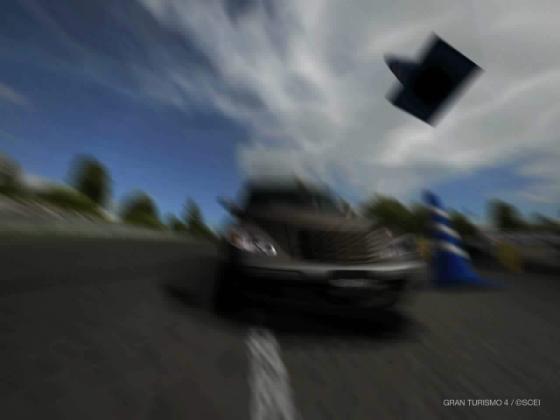
|
| Go Pt "Curser!!" |
|


